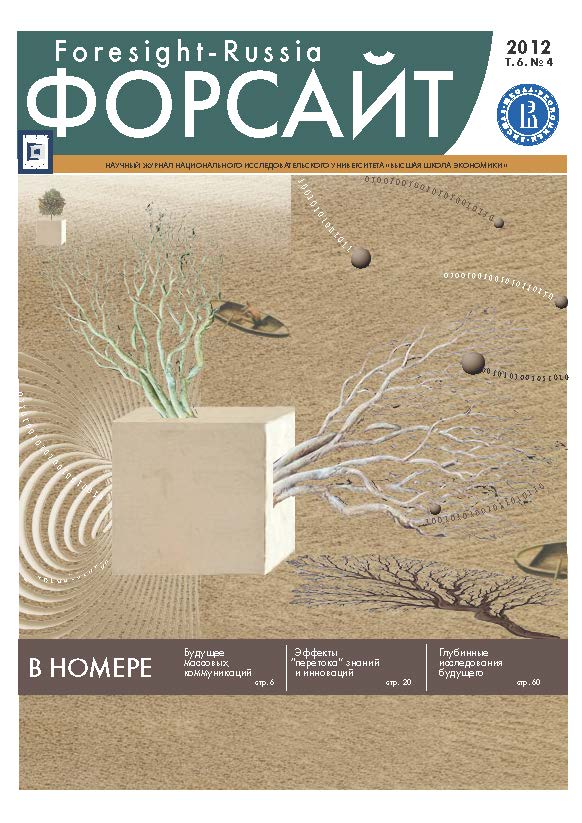Abstract
The paper is part of a large foresight study carried out by the authors at the HSE Institute for Statistical Studies and Economics of Knowledge for the Russian Ministry of Telecommunication and Mass Communications. It is important that mass communication, with its virtual product is related to two other sectors: telecommunications and information and communication technology. Technological transformations affect these three industries alike; the growth of bandwidth, convergence of terminals and growth of their computational performance are transforming products and markets in all three. Long-term trends in these markets have been well defined by a range of industrial experts. The conclusion of the paper provides recommendations for the revision of public policy.
The authors note only a few new tendencies in services and products. However, wide diffusion of these trends due to cheap technologies will lead to radical changes in the sector. New markets will appear as a result of expansion and adjustment of industrial relations between agents, previously independent of each other. Key trends are the abandonment of linear-media in favor of "user-controlled" consumption, with a growing amount of content produced by the user, and the spread of social interactions. The trends are interrelated and determine the transformation of business models, the sources of income, and the value of goods produced by the media industry. The most negative trend according to experts is "deprofessionalization" of content, which poses a risk for institutionalized forms of media. With such turbulent changes regulation in mass communications will inevitably undergo transformation. Henceforth it will not be able to rely upon content filtering and setting quotas. Instead the regulation should be built upon enabling a diversity of information sources to create the news agenda at the request of the audience.
References
Anderson C. (2006) The Long Tail: Why the Future of Business is Selling Less of More. New York: Hyperion.
Booth P. (2010) Digital Fandom. New York: Peter Lang Publishing.
Bradshaw P. (2008) News distribution in a new media world. Online journalism blog. Режим доступа: http://onlinejournalismblog.com/2008/01/02/a-model-for-the-21st-century-newsroom-pt4-pushpullpass-distribution/(дата обращения 2 ноября 2012 г.).
Castells M. (1996) Information Age. Vol. 1: Rise of The Network Society. Oxford: Wiley.
Castells M. (1997) Information Age. Vol. 2: The Power of Identity. Oxford: Wiley.
Castells M. (1998) Information Age. Vol. 3: End of Millennium. Oxford: Wiley.
Castells M. (2009) Communication Power. Oxford: Oxford University Press.
Castells M. (2012) Networks of Outrage and Hope: Social Movements in the Internet Age. New York: Polity.
Cisco (2011) Cisco VNI Forecast. San Jose: Cisco. Режим доступа: http://www.cisco.com/en/US/solutions/collateral/ns341/ns525/ns537/ns705/ns827/white_paper_c11-520862.html (дата обращения 9 октября 2012 г.).
Evans E. (2011) Transmedia Television: Audiences, New Media, and Daily Life. Oxford: Routledge.
Flew T., Collis C., Luck E., Shelly M., Bruns A., Jackson M., O'Donnell J., Tsai Y. (2009) Audience and Market Foresight. Trends and Foresight in Digital Media. Eveleigh: CRC.
Georgia Tech (2012) Future Media Outlook 2012. Georgia: Georgia Tech.
Hilbert M., Lopez P. (2012) How to Measure the World's Technological Capacity to Communicate, Store, and Compute Information. Part I: Results and Scope//International Journal of Communication. Vol. 6. P. 957-979.
IDC (2010) IDC Digital Universe Study. Framingham: IDC. Режим доступа: http://www.emc.com/collateral/analyst-reports/idc-digital-universe-are-you-ready.pdf (дата обращения 18 сентября 2012 г.).
IDPF (2010) International Digital Publishing Forum Database. Режим доступа: http://idpf.org/about-us/industry-statistics (дата обращения 24 августа 2012 г.).
Magna (2011) Magna Global Advertizing Forecast. New York: Magna Corp.
OCAD (2011) 2020 Media Futures. What will our media and entertainment be like by 2020?/Ed. V. Alstyhe. Toronto: OCAD.
Ofcom (2011) Ofcom International Communication Market Report. London: Ofcom.
Ofcom (2012) The Communications Market Report. London: Ofcom.
PwC (2012) 2012 Global Entertainment & Media Outlook. PricewaterhouseCoopers.
Rifkin J. (2000) The age of access: The new culture of hypercapitalism, where all of life is a paid-for experience. Putnam: Tarcher.
Strategy Analytics (2011) Connected Home Devices Service. Boston: Strategy Analytics.
Teljas C., Jonsson A., Enlund N. (2007) Where NEWS? Report 6: Drivers of Change in Media Channels. New York: IFRA.
Verna P. (2009) A Spotlight on UGC Participants. Режим доступа: http://www.emarketer.com/(S(zcjol0454gw0plmaiciprejw))/Article.aspx?R=1006914 (дата обращения 03 сентября 2012 г.).
Webb W. (2007) Wireless Communication: The Future. Chichester: Wiley.
Williams K., Petrosky A., Hernandez E., Page R. (2011) Product Placement Effectiveness: Revisited and Renewed//Journal of Management and Marketing Research. Vol. 7. P. 1-24. Режим доступа: http://www.aabri.com/manuscripts/10712.pdf (дата обращения 08 октября 2012 г.).
ZenithOptiMedia (2012) Прогноз развития рекламного рынка. М.: ZenithOptiMedia.
РАЭК, НИУ ВШЭ (2012) Экономика Рунета 2011-2012/Под ред. С.Г. Давыдова, И.В. Кирия. М.: РАЭК.
ФАПМК (2012) Телевидение в России: состояние, тенденции и перспективы развития (отраслевой доклад)/Под ред. В.П. Коломийца. М.: Федеральное агентство по печати и массовым коммуникациям.
ЦИРКОН (2012) Медиапотребление населения России: динамика и дифференциация. Режим доступа: http://www.zircon.ru/120615.htm (дата обращения 15 сентября 2012 г.).

This work is licensed under a Creative Commons Attribution 4.0 International License.

